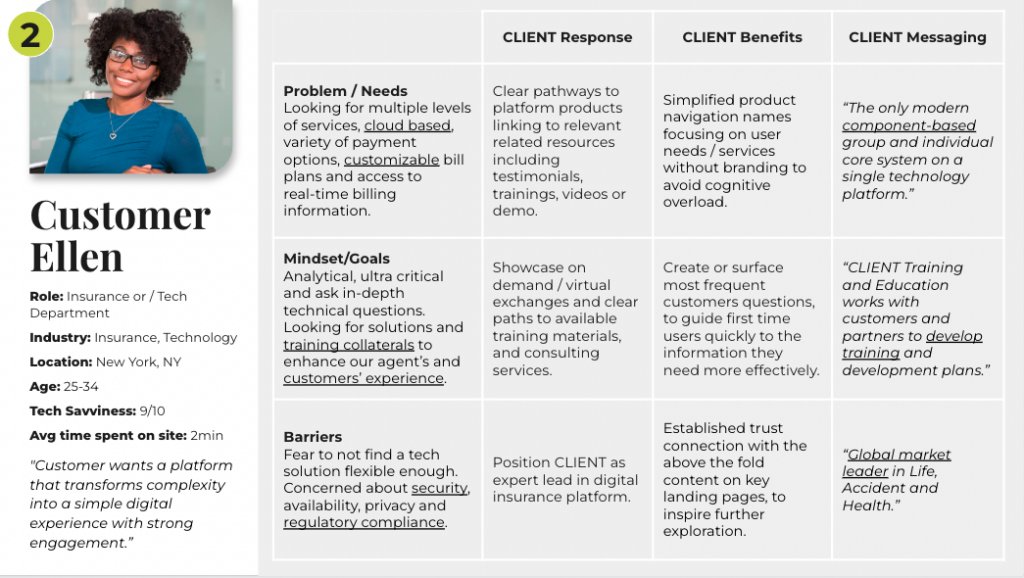Having a strong online presence is crucial as the internet becomes an increasingly integral part of our lives. But simply having a website is not enough — your website needs to be designed in a way that appeals to your target audience and helps you achieve your business goals.
That’s where personas come in.
A persona is a representation of your ideal customer based on qualitative and quantitative data and market research. Understanding user behavior will lead to more effective design decisions, as personas help web designers create websites that are tailored to the specific needs and wants of their target audience. By utilizing personas, designers can determine how users will interact with a site and what features they need or want in order to have a positive experience. This helps them create an optimized user experience and websites that actually convert.
Creating a persona might seem like a time-consuming task, and you may think you know your audience well enough to proceed without them. But don’t skip this critical step! Like any other tool you might use in your business, personas are an essential tool for any organization that wants to create a customer-centric approach to its marketing and product development. Taking the time to create a persona for your target audience supports your organization’s UX maturity, ensuring your website will be designed and developed in a way that not only appeals to user needs, but also helps you achieve your business goals.
Personas also make it easier to train future staff about your ideal customer base since you already have your audiences documented, and makes it easier for you to adjust your website on a regular basis as you can review and update the personas as they evolve over time.
Plus creating personas is actually fairly straightforward. First, you’ll need to gather data about your current customers through surveys, interviews, and market research. Once you have this data, you can combine it with quantitative analytics and behavior data in order to create a holistic picture of your users.
What’s included in a persona?
Personas generally include the following key pieces of information:
- Persona Group (i.e. Prospective Student or Donor)
- Fictional name
- Job titles and major responsibilities
- Demographics such as age, education, ethnicity, location, and family status
- Technical skills such as comfort level with technology, preferred device type, etc.
- A quote that sums up what matters most to the persona as it relates to your site
- Pictures representing that user group
- Add any accessibility needs (color blindness, motion sickness, poor vision, etc) this persona might have to ensure accessibility is baked into the initial strategy.
- Behavioral patterns such as how they use the website, what their goals are when visiting your website, their friction points, and your tactical response to their needs, etc.
Here’s an example:

Let’s expand on the behavioral part.
While most of the items on the above list are fairly straightforward and/or easy to determine from your analytics, that last bullet — behavior patterns — is the key part that needs to be analyzed and expanded. These patterns will not only determine the user journeys, but will also shape the narrative and storytelling through every page of your site, all the way down to the calls to action (CTAs) you use.
One example of an incredible and personalized customer experience is Chewy. They’ve created a human-centered, customer-centric brand. They understand the significance that emotion plays in customer purchase intent and decisions, then leverage their ability to create genuine customer connections to build loyalty and expanded market share. As such, their website is strategized and designed around user behaviors. They know what you’re looking for and how to make it easier for you to make that purchase.
And those customer connections? Chewy adds in a ton of personalization and brand personality; everything from email confirmations saying, “our paws are working on your order,” to sending condolence notes when a pet passes away. That kind of attention to detail allows Chewy to enjoy huge customer loyalty.
While your organization may not need the same level of personalization and customer service that Chewy provides, there’s lots of inspiration to be found in Chewy’s example. Ask yourself how you can connect with your users: what are their needs? Where do they want to go? How can you develop your brand voice to make stronger connections with them? Where do they get stuck on your website and abandon the task? Do they use different keywords to search your site?
Look at every touchpoint your user comes across in their journey on your site, and make it not only seamless for them to find what they need, but find a way to inject your organization’s personality into each of those steps.
Three to five personas is the sweet spot.
It’s rare when a website only has one audience. For example, an airport website could have travelers, loved ones looking for flight or pickup information, and people looking for business opportunities in its audience. A healthcare site could have current patients, caregivers, staff, and donors. It’s generally standard to have somewhere between three and five personas.
Look at your customers to determine how many you need. What different kinds of consumers do you have?
But keep in mind that it’s also critical to try not to be all things to all people. If you try to cater to too many audiences, you risk not creating a clear delineation between them, making it harder for you to attract, engage, delight, and convert any of them. Don’t dilute your message with too many personas.
A reminder about accessibility.
Kanopi is a huge advocate for web accessibility. Many audiences can need accommodations on your site — anything from needing help due to poor vision, color blindness, or vestibular needs. So we recommend wrapping in any accessibility needs for your personas at this initial strategy phase before the design and development of your site to ensure you’re keeping accessibility top of mind throughout your project.
I’ve created my personas. How do I use them?
Once you have your persona created, you can use them as a reference point during the web design process. Every time you make a design decision, ask yourself “would my persona enjoy this?” If the answer is no, then it’s probably not the best decision for your website.
Here are key ways that personas will guide your website:
- SEO strategy: do your personas use different keywords to search around on your website?
- User journeys: do your personas use different pathways to get what they want?
- Copywriting: do your personas respond better or worse to certain phrases or tone?
- Imagery: do your personas respond better or worse to certain imagery?
- Content strategy: do your personas respond to different manners of storytelling?
Also, consider the potential expansions of your brand; while personas are most commonly used in web design, they can actually be helpful for any type of marketing or product development. So if you’re looking to create a more customer-centric approach to any facet of your business, start by creating a persona!
Want to get started with personas? Kanopi can help.
Start by diving into our Step by Step guide on how we create personas for our clients. Or contact us and we’ll help craft them for you.
And remember: always keep getting feedback from customers as trends change over time. This will ensure that your user personas stay up-to-date with customer needs so you can continue offering valuable products/services no matter what industry changes may come.
Related content: user testing on a budget
Quality user testing does not have to be expensive. In fact, options are available for almost any budget. Derek Bermingham gave a webinar called “User Testing on a Budget” and outlined both how to conduct affordable user testing and how to recruit the ideal user base to deliver meaningful, budget-friendly insights. (44 minutes)










